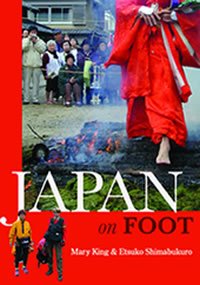
The articles below first appeared in the Look Japan magazine, as well as on its web site. The Japan on Foot book is *not* the same as the articles presented on this blog.
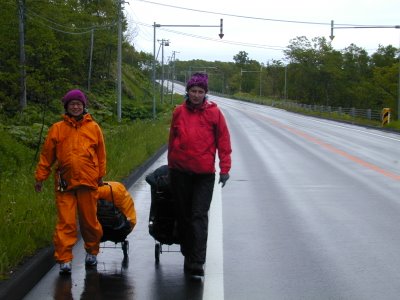
MAMA-CHAN WAS far from chuffed to learn that her daughter was going to spend one year traipsing the length and breadth of Japan.
"Women your age are usually married with children," she bellowed down the phone to Etsuko on the eve of our heading off to Hokkaido to start our walk from Japan's most northerly point to Yonaguni Island the westernmost island of Japan in southwestern Okinawa prefecture.
Neither of our families is too keen on our latest madcap venture. Just a few hours earlier my brother had called from England to determine my knowledge of bears. Telling him that we had purchased a red tinkly bell seemed to suffice, but Mama-chan was only consoled on hearing that after ten years, she'd finally get to see her daughter on home turf in Okinawa. Bidding us well, she hung up only to call back five minutes later to inform Etsuko, "I think your father's going senile." I guess Papa-chan is still none too happy with our plans.
Located at 45 degrees, 31 minutes and 14 seconds north latitude, Cape Soya is Japan's most northern extremity. Beyond its cliffs lies Russia. The barometer was wavering around the two-degrees mark when we hopped off the bus near the statue of Mamiya Rinzo (1775—1844), an explorer who studied under Ino Tadataka (1745—1818), the man famed for walking all around Japan in order to produce the first real maps of this island nation.
Apart from its sprinkling of souvenir shops, guesthouses and restaurants with billboards proclaiming the distinction of being Japan's most northerly this or that, Cape Soya is a no-man's-land. We checked into Saihoku no Yado (most northerly guesthouse).
"Women can't walk through Japan," guffawed the owner, Hirayama Masayuki. "It's tough enough for men; women can't do it," he chuckled, and then went on to inquire about the logistics of our trek. "See that postcard on the wall over there? That's from a 63-year-old man who walked from Cape Sata to Cape Soya." He proudly showed us the postcard he had received from an Ishii Akio of Tokyo who had walked from Kyushu's southernmost point to the northern tip of Hokkaido over the course of four months some four years before.
As we sat down to savour a dinner of octopus shabu-shabu, sashimi and bowls of snowy-white rice, Masayuki and his wife, Hisako, turned their attention to the news of the day. Images of a dead bear being pulled out of forest by hunters flickered up on the TV screen. "Two metres high," Hisako gasped in horror on hearing the size of the beast.
"In just four months seventy-seven people have been atacked by bears up here," Masayuki explained. "Four people killed this year, and a man's body was found in a bear's hole just the other day, so the hunters went to track it down. Let's hope they killed the right bear."
We hadn't taken one step yet but it looked like we'd have more to worry about than just blisters, shinsplints and backache once we hit the road.
CRISP SANDWICHES
My walking partner was trailing behind, head down and looking dwarfed by her fifteen-kilogram backpack. Etsuko was being buffeted backwards and forwards by lashing winds as we trudged along the winding coastal road towards Japan's northernmost city.
Still trying to shake off a vicious cold, she had been grumpy the past couple of days, snapping at me when I had bought bread and crisps at a small grocery store in Cape Soya just the day before hitting the road.
"But there may be nowhere to eat between Soya and Wakkanai," I reasoned, "And, there's nothing like a crisp buttie (potato chip sandwich) to raise the spirits when you're feeling tired. You know what a mad cow I'll be if I'm hungry and my blood sugar goes shooting through the pavement."The sky and sea met as one drab, grey blanket as we trudged through a wilderness of scrubland where the only signs of life were the occasional ramshackle house or upturned fishing boat, scattered buoys and fishing nets.
Apart from the scraggy hounds that pounced towards us on their long chains, snarling as we passed houses and small work yards, the only sign of life on legs during the morning came in the form of some yellow-helmeted construction workers.
Waving us on with his baton, one chubby-cheeked, middle-aged fellow bellowed over the howling wind, "Going to Kyushu?" His workmates roared with laughter when Etsuko announced that we are heading for Okinawa. "Ganbatte!" (Good luck!) they yelled, shaking their heads in bemusement. "We will need all the luck we can get," I laughed. "You should see the route we're taking!"
By 2 p.m. we were standing disheartened outside the closed doors of Fumi coffee shop, resigning ourselves to the fact that after making it halfway to Wakkanai we were now destined to eat nothing more than crisp sandwiches out in the cold and blustery winds.
But our luck was in. Just as we were about to set off on foot again, Masaru Nakano and his wife, Naoe, pulled into the driveway. Minutes later and Naoe was rustling up a spaghetti dish to the Muzak strains of "Happy Days are Here Again" as Masaru, a stout, chirpy fellow in his fifties showed off his water tank of pink, plastic dancing plankton and a vase of carnations that when turned upside down doesn't spill water.
"We get people walking up and down this road all the time," Masaru told us, "but usually it's just to Wakkanai or Cape Soya. We call you people kanizoku (crab tribe)."
It was dark by the time we hobbled past JR Wakkanai Station and found a traditional Japanese guesthouse for the night. By 8 p.m. we were sitting down, barefoot, to a dinner of fresh crab and warming ourselves with hot sake. The day's walk, some 31.9 kilometres, had taken us more than nine hours. For motorists it is just a half-hour whiz along Route 238.
NATURE CALLS
PHOTOS BY JAPAN ON FOOT 2001/2002
AFTER A month on the road we had walked more than 620 kilometres. Our route, a series of zigzags and circles, has taken us around Rebun and Rishiri islands, and then from Japan's northernmost city of Wakkanai south to Nayaro and out east to the Sea of Okhotsk. It will be a long and winding road before we reach Yonaguni Island, Okinawa, and dive out to what some claim is the lost civilization of Mu—Asia's equivalence of Atlantis.The first five weeks of our walk through Japan, however, has presented us with some of our biggest challenges. I have had days where I felt like my boots were full of burning pebbles, but now the blisters seem to have settled. We have also occasionally run out of drinking water on some of our hottest days.
Our fifteen-kilogram backpacks proved to be far too heavy so after two weeks of trudging under their great weight, Etsuko and I invested in two luggage trolleys on wheels, which we pull behind us. We get truck drivers and construction workers gawking at us as they try to fathom out whether we're nouveau-riche bag ladies or what. We also get truck drivers running a regular route who now hoot their horns at us and wave. There have been days when we've turned up at the front door of a traditional Japanese inn looking like two drowned rats, having trudged through thunderstorms and lightning.Etsuko and I have also been terrified by some reckless drivers on Hokkaido's roads as we've made our way along narrow shoulders on some routes where trucks and cars hurtle along without a care for those on foot.
Bears have been another risk during our trek through Japan's most northern reaches. We have seen bear prints on the sides of the road, and I even spotted a The bear didn't notice me at first, but having heard various stories of how some bears are now used to the sound of tinkly bells and have even acquired a taste for human flesh, I did what came naturally to me once bear actually eyed me—I screamed and legged it as fast as I could.
Vicious buyo flies have ravaged my arms and legs, leaving itchy, pussy bites, and while Etsuko now has an enviable sun tan, I look like a boiled octopus with mentaiko (spicy cod roe) ears and an ume boshi (salty plum) nose.We have argued about my roadside toilet indiscretions. "Why don't you pee further on down in that ditch, drivers can see you from here," Etsuko yelled at me out in the wilds of Otoineppu. "Because there may be snakes, and I also can't piddle with a load of nettles and weeds stuck up my bum," came my exasperated reply before I curled up with laughter at the thought that the sight of my lily-white, foreigner's backside might cause some truck driver to veer off the road.
Etsuko has tried to convince me that there are no snakes in Hokkaido, but after spotting one on a quiet lane on the outskirts of Abashiri she shrugged and tried to mollify me by saying, "It's dead, anyway. What are you panicking for?" We walked on for a few minutes before deciding to turn back and get a picture of the sleeping serpent, but it was no longer to be found.There have been occasions when we have wondered why on earth we ever decided to attempt such a walk, but the highlights of the journey and some of the characters we have met en route have turned each step into an adventure.We have enjoyed stunning mountain and forest scenery and regularly spot hawks circling the skies. We are enamoured with sights that we could never see if just whizzing by in a car. Hokkaido has a myriad colourful, fluttering butterflies. Daily, we hear the sounds of woodpeckers, the delightful birdsong of little cuckoos and nightingales, and have caught glimpses of heron flying low along the rivers and lakes.
UNBEARABLE ROADS
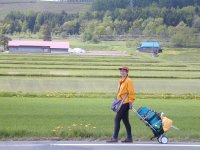
BEAR HUNTER Yoshio Kamigashima had come over to chat with us while Etsuko and I were sprawled out on the lawns of what is Japan's answer to the Great Wall of China. The village of Shimokawa completed its two-kilometre-long Mini Great Wall in 2000, in time for the new millennium and the hundredth anniversary of the town's settlement. It is a popular weekend hangout for locals in this part of Hokkaido.
Mr. Kamigashima, a spritely fifty-one-year-old with ruffled hair, asked us if we would like to see his hunting trophies, as well as his emu farm. We toddled over to his farmhouse to help feed the four Australian birds that make sounds like the revving-up of a motorcycle engine and lay eggs that are emerald green. Although Mr. Kamigashima considers the birds pets, he hopes eventually to sell their meat.
Inside his farmhouse, he pointed out the framed pelt of one of the forty or so grizzly brown bears that he has killed over the past twenty years. "I've actually killed the biggest brown bear recorded in Japan," Mr. Kamigashima told us, showing the bear-skin carpet that adorns his living room, as well as bear skulls and photographs of himself, rifle in hand, sitting on the bloodied corpse of what had once been a three-hundred-kilogram bear.
According to the bear hunter, official figures claim that there are up to three thousand bears in Hokkaido. Mr. Kamigashima, however, believes the bear population is much higher, so we keep on rigorously ringing our bear bells, hollering and singing as we traipse through densely forested areas.
As we reported last month, Etsuko and I spotted—and ran from—a brown bear on the road out of the village of Utsu. A couple of days later, over hot sake in the Ofukuro izakaya pub in Monbetsu, a fisherman chastised us. "The last thing you should ever do is show your back to a bear and run. They think you've given up and see you as bait," he explained.
Apart from bears, we face other hardships on the road. Due to the difficulties that we have faced sometimes in getting to a destination we have had to opt occasionally for a night in a bus shelter or sleep on the floor of a retired steam train. In 1957 the last steam train chugged out of the village of Kerochi, and in 1987 Kerochi Station closed its tracks for good. Today, for just three-hundred yen you can sleep on the train's floor. We spent a night on the old locomotive. Everything seemed novel and cosy at first until 3 a.m., when we awoke stiff from the cold.
QUEER HOKKAIDO FOLK
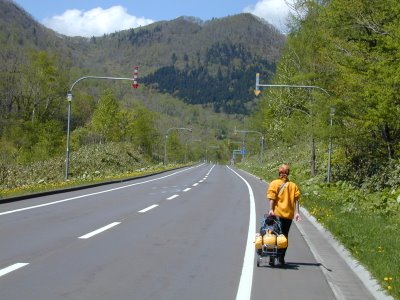
TRUCK DRIVERS, as well as the Self-Defence Force troops, have continued to show a spirit of roadside camaraderie as they pass us day in and day out along various Hokkaido routes. They toot their horns and wave. One right-wing trucker blasts out the Kimigayo, Japan's national anthem, and salutes us each time he hurtles past. We simply wish that he would think to slow down, but you meet all sorts on the road.
The builders, dressed in baggy, blue trousers and split-toe tabi, were chuckling over their shochu liquor as they spotted Etsuko and I entering the restaurant in our Teletubby rainwear.
"Where are you from?" the skinny one with a towel wrapped round his head asked me. "From England. London," I told him. "So what language do you speak there then?" he continued. I stifled a laugh and told him that we speak English in England. "Ooh," gasped his mate with the bleached blond hair, "You see, I told you. Everywhere these days people have to speak English."
If ignorance is bliss then I do believe that Hokkaido must have some of the happiest people in the world as I'm constantly amazed by the fact that few people seem to have heard of Britain or know what language its people speak. In Wakkanai, a waitress could not believe that Brits don't speak Russian, in Monbetsu a fisherman asked me if England was in Africa, and on hearing that my surname is King, a hotelier in Nakagawa inquired if I am related to Martin Luther King.
Etsuko, meanwhile, is often complimented on her Japanese speaking ability or has people accosting her for autographs when they hear she's from Okinawa and learn that her family name is Shimabukuro. "But you're really famous," gasped a young girl in a pub near Mashuko Lake, "You're a singer with the pop group Speed." Some people come out with real gems.
"Are you a man? You're far too tall to be a woman," the drunken trucker yelled at me across the restaurant). All 1.72 centimetres of me was tempted to reply that I'm a transsexual, but I simply answered, "Onna desu" (I'm a woman).
"What? The gaijin (foreigner) can speak Japanese," he screamed across at an elderly couple slurping their noodles by the window. "I've never heard a gaijin speak Japanese before. How can a gaijin speak Japanese? Is the other one a gaijin too?" His voice reached fever pitch as his excitement grew. "I keep passing them on the road; they've been walking for days," he informed the whole restaurant.
"Hey, gaijin, where are you walking to?" he continued. Etsuko turned round and informed him that we were on our way to Abashiri. "You can't walk to Abashiri; it's too far," he scoffed. "Actually, we've walked from Cape Soya and plan to walk to Okinawa," Etsuko continued. The trucker belched and looked at Etsuko agog: "Nihongo wa jozu desu (your Japanese is good)." "Thank you," she bowed her head, "I am Japanese."
BEAR ESSENTIALS
PHOTOS BY JAPAN ON FOOT 2001/2002
WE'RE BECOMING little experts on Hokkaido's most feared wild animal. Before setting off for Rausu, Akazawa Ayumi, who runs the Shiretoko Shizen Mura campground in Utoro, had filled us in on a few daunting facts.
First, that the Shiretoko Mountain Pass would lead us through one of Hokkaido's notorious "nests of the bear" as the area boasts at least one bear for every three square kilometres. Secondly, we learned that bear bells such as the ones we carry can have a Pavlovian effect.
The second piece of information came as a shock, especially when we came into contact with our second bear in less than three months in Hokkaido. This time, the bear was about seven metres away, walking parallel to us as we puffed up the deserted mountain road.
"Bears often follow trekkers to determine whether you pose a threat in their territory. If they believe you do, then they will attack," Akazawa told us.
A female with her cub, he warned us, is the most dangerous. "She will definitely strike." And, the problem with bear cubs, we learned, is that they like to play with humans; although what they consider play can be pretty rough stuff.
Bears in many parts of Hokkaido are blas? about the sound of traffic, are aware that where there are humans there's probably something tastier than a butterbur leaf on offer, and bells are a good indicator that trekkers are nearby.
"Many tourists, particularly photographers, come here, ringing their bells to feed the bears," Akazawa told us. "People want to get close-up bear shots but what they're doing is dangerous," he said.
 I estimated that the bear following us would stand at least three meters high. We knew we didn't stand a chance against the beast. "Stand perfectly still and look the bear in the eye," a bear expert had recently advised on television. "Do not show your back and run. If the bear moves towards you, throw stones at it. If it's not then scared off, be ready to fight," the expert explained, concluding with the sobering fact that all those who have been killed by bears this year in Hokkaido put up a fight, lashing out with large knives or machetes. "I've never heard of anyone who has survived a fight with a bear," he said.
I estimated that the bear following us would stand at least three meters high. We knew we didn't stand a chance against the beast. "Stand perfectly still and look the bear in the eye," a bear expert had recently advised on television. "Do not show your back and run. If the bear moves towards you, throw stones at it. If it's not then scared off, be ready to fight," the expert explained, concluding with the sobering fact that all those who have been killed by bears this year in Hokkaido put up a fight, lashing out with large knives or machetes. "I've never heard of anyone who has survived a fight with a bear," he said.
In Rausu, we discovered that bears like beer, the odd tipple of sake, and fruit juice. However, oolong-cha is not their cup of tea, according to Tomoko Kanomata, who runs the Kuma no Haitta Ie restaurant.
Some fifteen years ago, the Kanomata family was awoken in the night by a bear raiding the fridge. Inside the old wooden house, you can view smashed clocks, crockery and pierced drink cans from that fearful night. Photographs of the offending brown bear hang on the wall, and a huge iron cage takes pride of place in the lounge. "Just in case we need to trap another bear," Tomoko nervously giggled.
NONAKA NO CRY
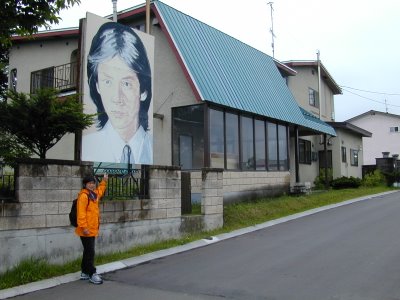

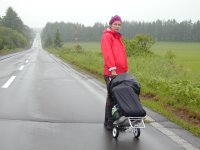
WE HAD schlepped for more than an hour off course in torrential rain to spend one night at Meakan Onsen. I was expecting a treat but I got more than I expected: foreigners are not welcome. Having been turned away from the two minshuku in the hot-spring area, Etsuko tried the Nonaka Onsen youth hostel. "Do you have a room for two?" she asked. "Who are you with?" asked the woman at the reception desk, looking first towards a Japanese man shuffling out of his shoes and then casting an eye my way. My heart sank into my boots as Etsuko pointed towards me and the woman replied "Chotto matte, kudasai (a moment, please)," poked her head around an office door to emerge a moment later and announce, "We're full."
It would be another thirty-kilometre schlep to the bus shelter out in no man's-land. A woman, who had spotted us on the road earlier that morning, came over to chat. On hearing our problem, Tsuda-san perked up: "You can share my room." Etsuko and I insisted that we would each pay the night's full rate for the room and so Tsuda-san asked the woman on the reception desk. "It's not possible," the receptionist snapped, "it's against our rules for you to share."
Etsuko bluntly asked the woman if the hostel had a "no-gaijin policy." She denied it but later that day, after we had traipsed past the "bus shelter" that turned out to be nothing more than a bus sign on the pavement, a local woman told us, "They don't let foreigners stay there. I don't know why."
We had no choice but to carry on to Ashoro, a town famed for Japan's biggest butterbur leaves and for being the childhood home of singer-songwriter Chiharu Matsuyama. We popped over to have a chat with the mother behind the man—Miyo Matsuyama, a sprightly eighty-year-old with short grey hair and glasses whose passions in life include mountain vegetable picking and chain-smoking.
A huge mural of Chiharu in his mop-haired seventies hey-day hangs outside the Matsuyama home. Today, forty-five-year-old Chiharu sports an egg-head look. Miyo-san's favourite memory of her son is as a junior high school pupil when he went door-to-door, selling natto (fermented soybeans). "That's how he got the money to buy his very first guitar," the old dear reminisced, "by selling natto to the people of Ashoro."
Rain was pelting down as we left Ashoro. Suddenly, a white jeep turned round on the road and hurtled back towards me. A youngish fellow with a completely shaved head peered over dark glasses and said something that I failed to catch. I assumed he was offering us a ride and politely I turned him down.
Etsuko caught sight of the Kojak look-alike as he pulled back out onto the road and gave a piercing shriek: "Don't you know who that was?" As I watched the jeep disappear over the brow of the hill, it dawned on me: "Bloody hell! I've just turned down a ride from Chiharu," I howled.
LEAVING HOKKAIDO ISLAND


WE COULD still hear the chuckles of the construction workers as we left Kikonai behind and plodded on in the direction of Hakodate. It was the final day of our walk through Hokkaido, a trek that has covered almost two thousand kilometres. Honshu now lies ahead of us.
Assisting us with our luggage trolleys, a construction worker asked us where we were walking. The six workmen curled up with laughter on hearing that we were en route to Hakodate.
"It's about fifteen kilometres; you can't walk that far," a young chap giggled. "But we've walked from Cape Soya," I told him. There was stunned silence. "Well, you must be happy to finish your walk now," a middle-aged man piped up, wiping the sweat from his face with a dirty sleeve. "We walk Honshu next," Etsuko told them. "So where are you really walking to?" another chap tittered. I explained that our goal is Okinawa. The construction men creased up with mirth.
Our last few weeks in Hokkaido were some of the most exciting of our journey so far, with us, finally, coming face-to-face with bears at farms in Noboribetsu and at Showa Shinzan.
We also witnessed the aftermath of Usuzan's eruption of 2000 and talked to survivors of the tsunami that devastated Okushiri Island back in 1993.
But perhaps our most memorable day was at Mannenji temple in Manji village, northeast of Sapporo. There, we saw a doll that is believed to be possessed by the spirit of a dead little girl.
Crow black hair sweeps down past the thighs of the Okiku Ningyo that sits on the temple's altar yet, when she was bought 82 years ago, her hair is said to have been above chin length.
"She hasn't had her hair cut for ten years now," Junsho Imagawa , the monk told us. "But it continues to grow, although very slowly these days." Mr. Imagawa appeared afraid of the doll that was handed over to his father during World War II.
When Suzuki Kikuko passed away at the tender age of three her parents forgot to cremate her beloved doll with her. But, her elder brother, Eikichi, placed the doll on the family altar and played with it each day. "Eikichi started to notice that the hair was growing," Mr. Imagawa told us.
Just before the grown-up Eikichi was sent off to war in Sakhalin, he handed the doll over to Juno Imagawa at Mannenji temple. "When Eikichi returned to see the doll after the war, her hair had grown significantly longer," Mr. Imagawa continued.
I lay a bag of sweets on the golden altar as Etsuko lit some incense and offered a short prayer. In the flickering candlelight, the Okiku Ningyo's face took on a human, childlike quality and my heart skipped a beat as I looked into the doll's dark eyes. For a moment, I could have sworn she blinked.
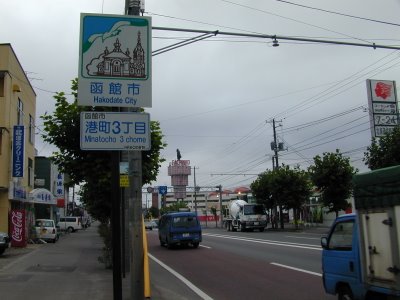
www.flickr.com
|



3 comments:
What a great site »
And I thought I was hard-core to walk 2000 miles across Japan, and here I see you walking more than twice as much! Puh!
Although you don't seem to be carrying your stuff, which seems like a pretty smart move given it's pretty bothersome.
I also have a blog on http://sata-soya.com/, feel free to get in touch sometime to discuss memories!
Greetings,
Josef
Hi Josef, great you walked Japan too. Because of the weight of our computers and camera gear we resorted to using trolleys after 3 weeks. We were reporting from the road as we went so had to carry a lot of tech gear that at that time was quite heavy. Anyway, I'm glad you found my blog and enjoyed reading it. The Japan on Foot book is so much better though. It's available as an ebook on Amazon and can be bought as a print book via Fine Line Press, New Zealand. Great that you blogged about your journey too. Best wishes and hope you enjoy more walking adventures.
Post a Comment